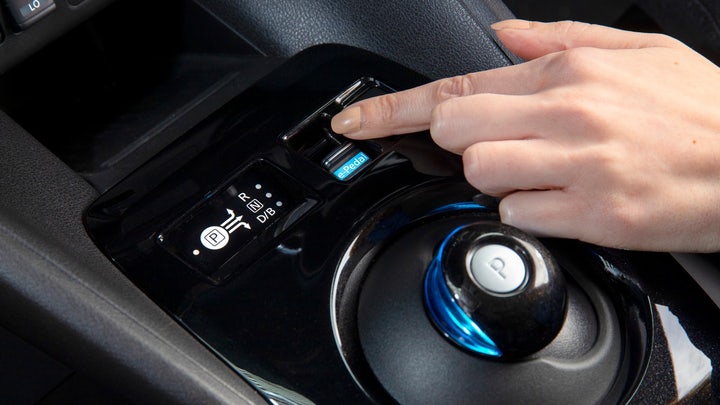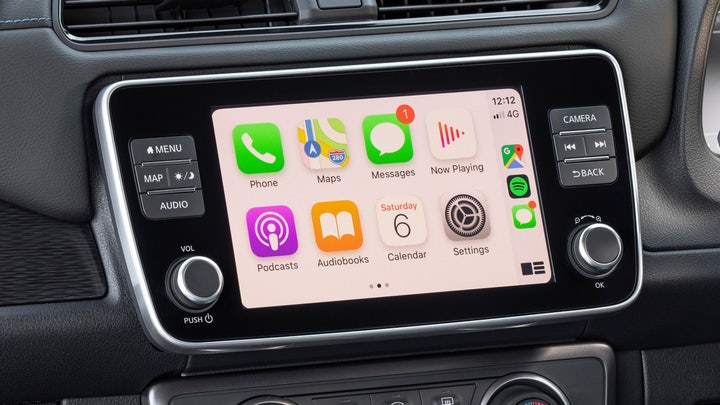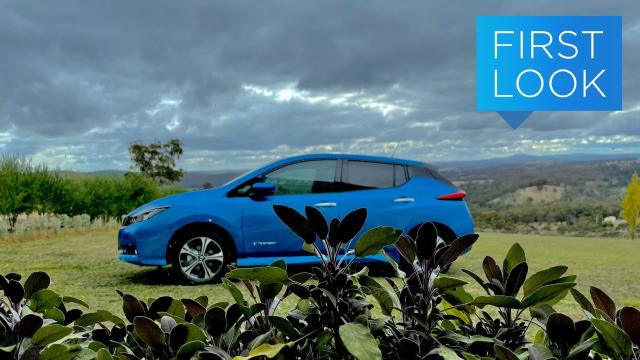The Nissan Leaf e+ is finally hitting Australia. I got to spend a few hours with one and have some initial thoughts on the brand new EV.
The Nissan Leaf e+ is an upgraded version of the regular Leaf, which first entered the Australian market in 2012.
The Leaf is a more compact EV that has generally been aimed for city and suburban drivers. The Leaf e+ is clearly trying to extend its range, quite literally beyond those confines.
Nissan took us to rural Victoria for testing — a clear indication that the brand is hoping that the bigger battery and other upgrades will reposition the Nissan Leaf as an EV for all occasions, including longer drives.
The Nissan Leaf e+ has a bigger battery
In 2019 I called out the range on the Nissan Leaf as a potential problem. At 270km it’s not bad for a city dweller or suburbanite, particularly if they had someone to mount that handy home wall charger.
But as someone who likes to go on hikes on the weekend and has relatives a couple of hours away, the range anxiety was real.
The Nissan Leaf e+ has a much larger battery, coming in at 62kWh, where the Leaf sits at 40kWh.
But despite the larger battery, it can also charge faster. The Nissan Leaf e+ can go from 20 to 80 per cent in 45 minutes, which is roughly 15 minutes faster than the regular Leaf.
The Nissan Leaf e+ also has more range

The bigger battery also extends the range to about 385km, which is a vast improvement. And so is the range estimation, which Nissan tells me is largely improved compared to the first few generations that could be wildly inaccurate.
That being said, more than just driving can impact the battery life.
Nissan was careful to mention that a more efficient way of warming yourself was by turning on the seat and steering wheel warmers, rather than using the aircon.
So like with any EV, you’ll want to keep an eye on what other factors may be sucking your battery, like sat nav.
While we made it out to rural Victoria and back with about 17 per cent battery left, that included using an external Tripy GPS, no aircon and we took advantage of the battery-saving ePedal.
[related_content first=”1690702″]
This is where public charging options continue to be important. Two years on and I’m still renting an apartment.
I can’t simply plug in an EV at the end of the day. While there are slow improvements happening when it comes to public EV infrastructure (of which Nissan is a vocal advocate) we’re still dealing with a resistant government.
Until there are more viable options for people who don’t own a detached home in Australia, there’s always going to be range anxiety and concerns about charging.
Of course this is by no means a problem exclusive to Nissan. In fact, the company is striving to change this.
But it’s still an important consideration for potential buyers looking to make the EV switch, especially when the cars are still comparatively expensive.
The ePedal doesn’t feel like Mario Kart anymore

In my 2019 review of the Leaf I said that Nissan proprietary ePedal made the driving experience feel like a bit like playing Mario Kart.
The ePedal allows you to use just one pedal that will accelerate when you put your foot down and decelerate simply by backing off the pedal. This removes the need for braking and is also more battery efficient.
It can take some getting used to, and the 2019 ePedal was quite sensitive.
The Leaf e+ ePedal was thankfully not as touchy. It didn’t jolt forward anywhere near as much as its predecessor and the braking functionality was more measured.
This is a welcome change because it made the experience feel less like a a go-karting experience.
Still, if you prefer to drive in a more traditional fashion, there is still an individual accelerator and brake for you to use.
The Leaf e+ drive was smoother

Nissan was bold enough to not only take us hours out of the city, but also on some pretty bumpy country roads.
It became clear quite quickly that the company was trying to flex on the improvements to the drive, as well as the extended range on the Leaf e+.
And it wasn’t wrong.
The Nissan Leaf e+ does feel like a more mature drive when you’re behind the wheel. While you’re always going to feel bumps on a dirt road, it held up remarkably well for a non-SUV.
The drive was surprisingly smooth and combined with the aforementioned ePedal improvements it seems like the Leaf has finally grown up.
The infotainment and safety tech are basically the same

When it comes to the Nissan Leaf e+ tech, there’s some fun stuff but nothing we haven’t seen before.
The e+ has an 8-inch infotainment touchscreen with Apple CarPlay and Android Auto capabilities, as well as USB-charging ports.
Like the 2019 Leaf, the internal Maps system feels a little outdated. But then, I am not partial to internal sat nav in most cars. While it may hurt my data, I prefer the live maps and updates that Google Maps provides.
There’s also the aforementioned heated seats and steering wheel which are admittedly very nice.
On the safety side of things it’s equipped with:
- Intelligent emergency braking
- Lane departure alerts
- Collision and blind spot warnings
- Cross traffic alerts
- Reverse camera
The alerts I actually got to try were similar to the regular Leaf in that they were present without being intrusive. I’m not a fan of overly sensitive warning systems that can freak a driver out. The Nissan Leaf e+balanced this well.
The Nissan Leaf e+ isn’t cheap
An EV that isn’t cheap is nothing new. Most EVs in Australia barely come under $50,000, including the regular Leaf with is still $49,990, plus on road costs.
Being an upgraded model, the Leaf e+ is more expensive again, starting at $60,490. Plus you need to take the home charger into account. If you want one it costs a couple of thousand dollars extra.
It’s a big investment. You get a lot more for that price in petrol and diesel cars.
But this isn’t a Nissan specific problem. It’s an industry issue. And while this is a product review, context matters.
[related_content first=”1680754″]
The price is around the same as the Mini Cooper Electric SE and the Hyundai Kona Electric. And there are only a handful of EVs with cheaper price tags in Australia.
When you live in a country that is so hostile towards EVs, it’s a tough sell. There are few state and zero federal incentives to improve the return on investment, and many EVs still get hit with luxury car tax (though low emission vehicles are charged a lower rate).
And then you have the Victorian government trying to introduce a road usage tax which would be fine if it was balanced with uptake incentives, but it isn’t.
So we’re left with what feels like an attack on EV uptake, or at least a severely shortsighted approach to the future of transport.
So yes, the Nissan Leaf e+ isn’t cheap. But it is largely a product of a broken system where sustainable practices can only be afforded by the top one per cent.
[related_content first=”1686796″]
Bi-directional charging and sustainability is step closer
One thing I appreciated about the 2019 Nissan Leaf was that included bi-directional charging capability… despite the fact it couldn’t actually be used yet.
What this does is allows a charge to go both ways, allowing you to store energy in the car battery and then use it to power a home. Or feed back into the grid.
I liked this because it future proofed the car. Being a company that preaches sustainability, this was a great way for Nissan to prove that it wanted you to keep the Leaf for years.
It also tapped into Nissan’s vocality on the subject of sustainable infrastructure and wanting to lead that conversation. In the past Nissan has said that it wants its EVs to be considered portable batteries, not just cars.
The Leaf e+ of course has bi-directional charging as well, and two years on it feels a little bit more like a reality. Eventually, anyway.

At the moment Nissan is still the only 100 per cent EV car manufacturer in Australia to offer bidirectional charging. But it sounds like that may change in the near future.
“Nissan is participating in trials that will be deployed in Australia to demonstrate the benefits of this technology to consumers, businesses and the national electricity market,” Nissan said in a statement.
While I still firmly believe that this technology needs to become more democratised and accessible to actually be beneficial, I appreciate that we’re slowly crawling closer to sustainable energy options.
Should you buy it?

I always say that I can’t encourage anyone to drop tens of thousands of dollars on something after only spending a few hours with it. And that remains true here, especially given it’s the more expensive Leaf option.
If you’re a fan of EVs but looking for something with more range, it’s perhaps worth considering.
But I’m still left wondering what my perspective would be if I had more of a lived experience.
Even with the increased range, I struggle to see the long-term viability of EVs for people who rent, particularly apartment dwellers like myself.
I can’t install a charger at my place. And the places you can publicly charge quickly and conveniently are few and far between, even in major cities.
I’d love to be proven wrong. Perhaps an EV would slot conveniently into my life. But without that real world experience it is difficult to determine.
And it’s sad that I feel that way because I truly believe in EVs and respect what Nissan is doing in this space for the entire industry, not just itself.
While Nissan is fighting hard for change, it’s still an uphill battle in Australia. And I desperately hope we see that change.
